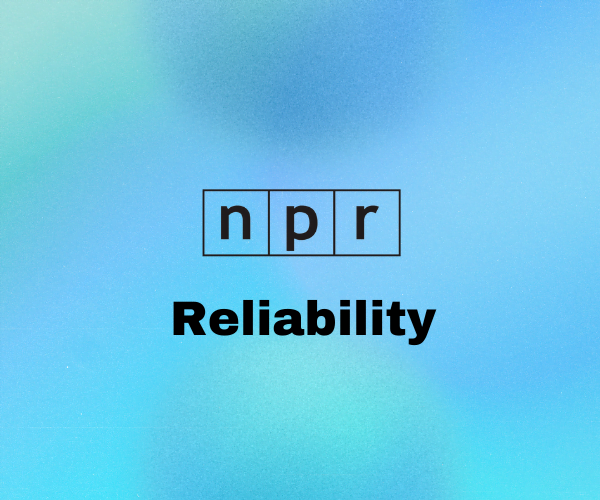
National Public Radio (NPR) was founded in 1970 and is headquartered in Washington D.C. From 2017 to 2022, Statista found that NPR is the tenth most reliable news source based on their surveys. According to Statista, 44% of adults surveyed in 2022 agreed that NPR was a credible source. In comparison, ABC and CBS were the most credible news organizations according to Statista’s 2022 survey, at 61%.
Statista also stated: “Finding trustworthy, impartial news sources can be difficult for audiences in a world where fake news is in constant circulation and bias in news is a growing concern. More than 50 percent of total respondents to a survey held in early 2020 believed that there was a fair amount or a great deal of bias in the news sources they used most often. The same study found that close to 70 percent of respondents were more concerned with bias in news that other people may consume than with their own news source.”
Despite NPR’s relatively strong reputation, the news outlet is not infallible and has published inaccurate information in the past. At Biasly, we endeavor to evaluate the accuracy and dependability of all media outlets. Let us investigate the reliability and accuracy of CBS News.
Does Reliability Matter?
Reliability, in general, refers to how trustworthy or accurate information, or in this case, a news source is. If we consider this definition, it quickly becomes clear why reliability is important in media sources. If we can’t trust the things we read then there isn’t much of a point in continuing to consume content from that source, after all. So how exactly can we gauge the reliability of a news source anyway?
There are several potential measures of reliability to look out for when trying to determine whether a media source is reliable or not. Red flags for an unreliable article can include the presence of wild unsubstantiated claims, facts dependent on other unreliable sources, heavy use of opinionated language, and more. Some indicators of a reliable news source, on the other hand, include things like:
- Absence of subjective/opinionated language in articles
- Credible sources cited (e.g., neutral sources, .gov, .edu websites)
- Facts and statistics backed by multiple relevant outside sources
- Use of primary sources when possible (e.g., interviews, quotes)
- Information that remains consistent across news sources
So How Does NPR Fare in its Reliability?
The political reliability index developed by Biasly objectively assesses news organizations’ accuracy and trustworthiness. NPR’s overall Reliability Score has been rated as ‘Good’ by Biasly. This rating is a weighted average of two distinct scores: the Fact Analysis Score and the Source Analysis Score, each evaluating separate components of NPR’s Reliability. When computing the Average Reliability of the article the Fact Analysis score is more heavily weighted. These ratings are as follows in the next two paragraphs:
NPR’s Fact Analysis Score is ‘Good,’ which suggests readers can trust most of NPR’s content online. The Fact Analysis score focuses more on the accuracy of claims, facts, and sources presented in the article and any hints of selection and omission bias, which we will discuss further in the article.
NPR’s Source Analysis Score is ‘Fair,’ which suggests readers can trust some of the sources, links, and quotes provided by the news source. This score, which is based on A.I., focuses on assessing the quality of sources and quotes used including their number, lengths, uniqueness, and diversity.
However, since these scores are based on percentages and averages, individual articles could be more or less trustworthy depending on the context, author, and other factors. Our findings show that NPR’s reliability is mostly but not all factual because they have retracted several stories in the past or had pieces that were not factual.
Let us analyze the supporting data for NPR’s rankings and discuss what to watch out for while searching for trustworthy news sources.
NPR Accuracy and Reliability
The reliability of news organizations is significantly impacted by bias and political orientation. NPR, like countless other media outlets, has occasionally been accused of prioritizing the liberal agenda at the expense of facts. We can find out if this is true by assessing the accuracy of NPR news articles and determining how well the organization backs up claims with facts. As we evaluate the accuracy and factuality of their articles, we’ll be looking for selection and omission bias.
Selection bias is when stories and facts are selected or deselected, often on ideological grounds, to create a narrative in support of the new sources’ ideology. Omission bias, on the other hand, is when different opinions and political views regarding a situation are left out so that the reader is only exposed to the ideological perspective supported by the author. It’s important to keep in mind these two types of biases when trying to assess an article’s level of accuracy.
Biasly assigns a percentage score to accuracy, with one being the least accurate and 100 being the most accurate. Ratings are determined by measuring claims with factually backed reasoning, credible sources, and the number of credible external sources used within an article. A full page at Biasly’s website includes dependability and accuracy ratings for newly released NPR news stories. As previously mentioned, NPR has “Good” reliable on average based on the articles analysts have rated. This score can vary from article to article, though, and the most extreme variations in dependability are caused by bias, notably omission, and selection bias. Consider The Wall Street Journal, which has a somewhat conservative bias and has “Excellent” reliable according to Biasly. For example, they have an article that has “Fair” reliability titled, “New York State to Debut First Cybersecurity Strategy” and another article called, “Opinion | Trump’s Jan. 6 Trial: We Owe It to History” that is “Poor” reliability. Regardless of an outlet’s overall reliability, each article needs to be thoroughly evaluated for bias.
For example, an NPR article titled, “How many voters does it take to make a majority? Why Ohio’s Issue 1 is Controversial” is rated medium liberal and is somewhat close to the center. Concerning the selection and omission bias, the author Karen Kasler does a good job reporting the facts of the story without overtly inserting her opinion. However, Kasler’s selection of majority liberal-leaning sources and viewpoints validate the ‘Medium Liberal’ label. To exemplify:
“It was a rush job on a monumental question, shifting a 111-year-old right that Ohioans have had to amend their state constitution to making it darn near impossible to do so with a 60% threshold,” Curtin said.”
This article portrays a moderately liberal stance not because of the inclusion of liberal sources, but because of the lack of balancing conservative voices. As so, the article implicitly slides towards positively associating with the liberal cause like many NPR stories, even if only slightly. If Kasler included one or two more conservative viewpoints in her article she could have provided a more holistic view of Ohio’s Issue 1 ballot measure. Regardless, this article can be considered mostly reliable.
We’ll cover more examples like this below, providing further analysis with examples of NPR’s reliability, including its use of selection and omission bias and the quality of sources and facts used.
Analysis of Reliability in NPR Opinion Pieces
Opinion-style journalism is a suitable venue for reporters to express their opinions and beliefs, even if excessive opinion might be something to avoid while producing a general news article. Even though opinion articles are less reliable due to their subjective nature, they can still be worth reading for the sake of broadening one’s understanding of various viewpoints across the political spectrum.
NPR’s opinions have caused some issues in the past with their reliability because of their tendency to promote liberal causes and individuals. The organization has been involved in several controversies about receiving government funding while promoting liberal ideologies. Specifically, they were accused of bias in their Independence Day coverage when they explored Thomas Jefferson’s relationship with Sally Hemmings, Jefferson’s slave. NPR’s predominantly liberal story selection is the biggest cause of reliability issues.
Quality of Sources and Facts Used
NPR is generally good at using high-quality sources from both sides of the political spectrum and citing facts as evidence, but this isn’t the case for every article. For instance, think about, “Opinion: America’s shameful obsession with guns”. In this article from Scott Simon, he only used two quotes from the same person. One of the quotes is medium-length and the other is short.
In addition, the author’s two sources for the article are as follows:
- The Small Arms Survey
- The Gun Violence Archive – two separate statistics used.
Overall, the quality of the sources in the article is high; however, the article needs more sources to build a sound argument. As a general rule, articles need more than two unique sources. The facts Simon presents are logical for the author’s purpose of lamenting the number of guns in the U.S.; however, they are overly general and lack specificity. Furthermore, the author does not present any oppositional viewpoints, which further hinders his objectivity. Additionally, both of the quotes used display a strong liberal bias.
Throughout the article, Simon selectively uses sources with a liberal tilt and does not try to balance them with conservative perspectives. The evidence points to this article being strongly liberal-leaning and not a trustworthy source for information on the gun violence debate.
The next article we will analyze is a good example of opinion writing with excellent sources and facts. The article, “The U.S. promised Ukraine cluster bombs. In Laos, they still kill civilians” by Lewis M. Simons gives a detailed history of the Vietnam War and then explains the long-term effects of cluster bombs. The author uses six non-partisan sources such as the Department of Defence and the Pentagon. Furthermore, the author utilized a compelling primary source, Laotian children who have been maimed by unexploded ordinances. This is an example of an opinion piece with quality sourcing, quotes, and objectivity. As such this is opinion writing at its finest.
Selection and Omission Bias
In another example from NPR, we can see the author’s distaste for Donald Trump even though she tries to be objective. The article, “In Op-Ed, 10 Ex-Defense Secretaries Say Military Has No Role In Election Dispute” by Jaclyn Diaz focuses on ten ex-defense secretaries who condemned Trump’s election lies. The article has an ample number of quotes, with 8. All of the quotes used have an overtly anti-Trump bias, with no balancing viewpoints. This results in Trump’s election debacle being characterized as a coup, which clearly demonstrates liberal selection bias. Here we see the quote from Former Secretary of Defense Ashton Carter:
“I am not troubled by the word ‘coup,’ ” Cohen said. “I think it means an extra-judicial, extra-legal action that opposes rule not by the people but by a select few.”
Throughout the article Diaz does a good job of avoiding loaded language; however, the omission of sources with a positive view of Donald Trump is the primary hindrance to objectivity. While NPR goes to great lengths to avoid publishing overtly biased content, its slight liberal bias is evident in this article and many others.
In the article we discussed earlier, “Opinion: America’s shameful obsession with guns” the author omits any comments from conservative-leaning opposition. Simon overtly portrays the issue from a liberal perspective and refuses to account for other viewpoints, which hurts his reliability. Lastly, the title of the article frames the argument as liberals vs. ‘shameful’ conservatives – which is a poor way to start a, ideally, productive conversation.
In opinion pieces, issues with faculty, sources, selection, and omission are frequently present. The articles we’ve covered so far range from significantly biased to impressively objective for an opinion piece. As a new organization with a slight liberal slant, NPR has a minor incentive to continue playing to liberal views to keep its large liberal-leaning base engaged. But now that we’ve enumerated typical trustworthiness indications, you can stay up to date by keeping yourself informed on the most accurate news.
So is NPR Reliable?
Ultimately, NPR is a very reputable and reliable source with a strong positive reputation for journalistic integrity. As with all publications, there are some outlier cases, so it could be said the accuracy of its articles varies. The more you study the topic of media reliability, the easier it will become for you to identify issues with factuality, sources, and selection and omission. To help with this, you can use Biasly’s News Bias Checker to uncover reliability problems and assist you in finding the most accurate and dependable news.


























